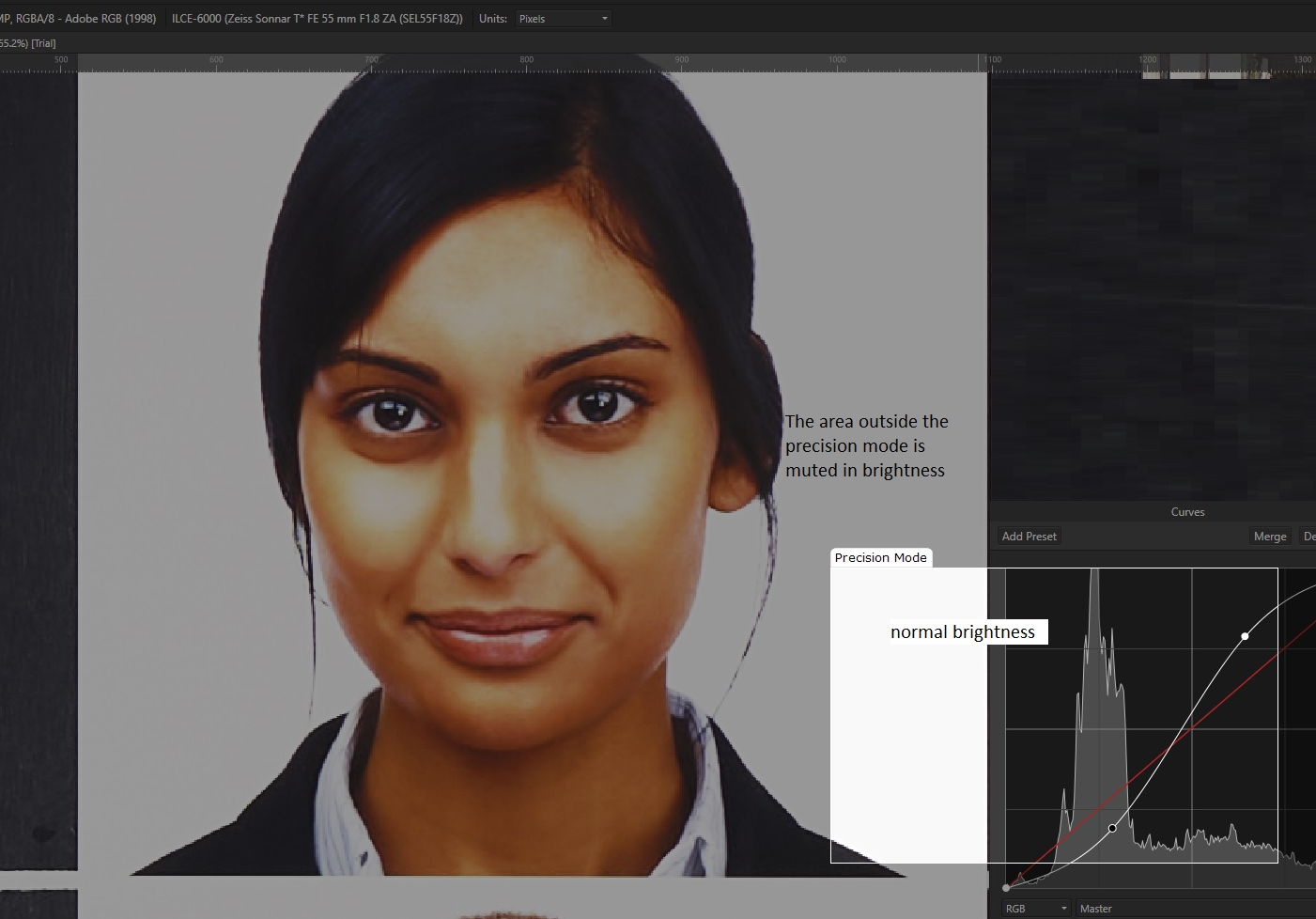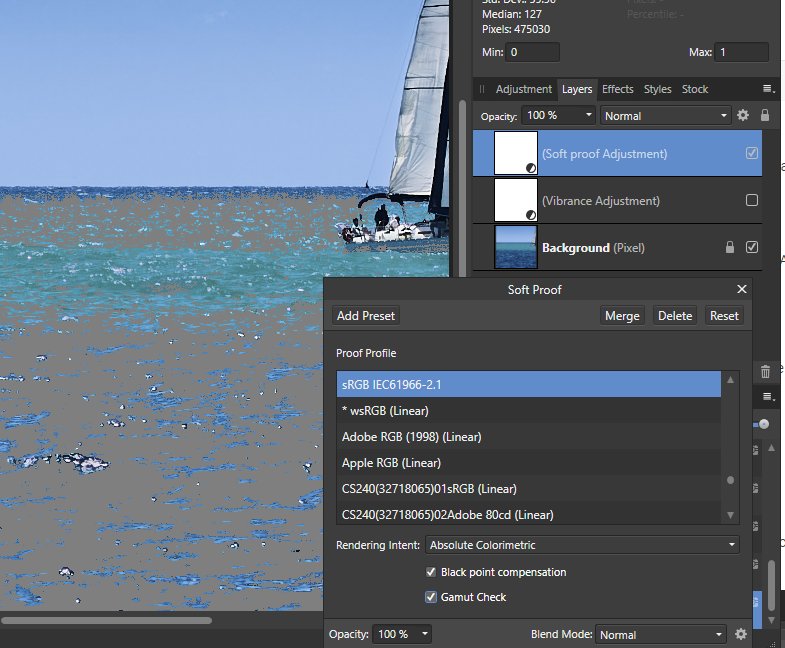
Wendelin
Members-
Posts
11 -
Joined
-
Last visited
Recent Profile Visitors
The recent visitors block is disabled and is not being shown to other users.
-
 RichardMH reacted to a post in a topic:
Soft proofing sRGB not working
RichardMH reacted to a post in a topic:
Soft proofing sRGB not working
-
PixelEngineer, Are you a member of Affinity staff? If so that let's me rethink my choice for Affinity. There is a requirement from more than one user which should be taken seriously just because of that. You're wrong in telling us that softproof is ONLY print related, though this was the origin and the major use case BEFORE wide gamut monitors easilty available and excessive distribution of photographs over the web. And the help file you linked doesn't say anything about print either, instead it says what any decent internet source says: Also, your proposed workaround to export a file is far from being a preview and not up to the task to allow for live adjustments to an image before exporting.
-
My printing service has a similar statement, and this relates to their ICC paper proof profiles. They can be used for softproofing, but the file you send them must be in whatever they require, my service requires the standard color spaces sRGB or Adobe RGB(1998). It is not a problem to embed one of those profiles, on contrary, if nothing is embedded they assume sRGB. Just don't embed the softproof profile you have downloaded from them.
-
Wacom Intuos Pro tablets Precision mode
Wendelin replied to Wendelin's topic in Feedback for Affinity Photo V1 on Desktop
If you are a Wacom user, how and when do you use the precision mode? -
Hi Anon2, Thank you. Yes, I have misunderstood. I now downloaded and installed the profile sRGB-elle-V2-srgbtrc.icc. I've also read more from her website and I am really astonished that the sRGB profile which was meant to standardize and ease color management seems to have diverged into so many differing profiles in the real world. https://ninedegreesbelow.com/photography/srgb-profile-comparison.html I made a simple test with one of my JPG images from an Olympus camera. The file has an EXIF tag sRGB (not the full profile) as revealed by exiftool used as described by Elle's article: https://ninedegreesbelow.com/photography/embedded-color-space-information.html The image is colorful especially in the red department. Now I opened this file in Capture One 20.0, Gimp 2.10.18, Affinity 1.8.6.641. The colors in Capture One and Gimp look quite similar, if not even identical. Affinity shows the red slightly muted and some blues are a bit shifted and desaturated. Capture One possibly uses the "sRGB Color Space Profile.icm" in my Windows system folder, but maybe its own "sRGB Color Space Profile.icm" profile in the app folder. Gimp says it uses the "GIMP built-in sRGB" profile Affinity it probably using sRGB IEC61966-2.1, as configured in the preferences. C1 = GIMP <> Affinity I assigned the profile "sRGB-elle-V2-srgbtrc.icc to this image in Gimp and Affinity (C1 does not have this option). I cannot observe any color change. Still: C1 = GIMP <> Affinity When assigning sRGB-elle-V4-g22.icc to Gimp and Affinity, an can see ever so slight color change with this image. Not much so. Still: C1 = GIMP <> Affinity Changing Monitor setting sRGB or Adobe RGB does not influence this discrepancy. As if color management between devices and color spaces wouldn't be complex enough for the normal photographer, industry standard profiles and / or different applications behave differently and or have bugs. Mankind has flown to and walked on the moon some 50+ years ago, and even built compatible space station parts even across political systems, but this digital image industry can't get a few colors right??? 🙂 Thanks and regards
-
 Old Bruce reacted to a post in a topic:
Wacom Intuos Pro tablets Precision mode
Old Bruce reacted to a post in a topic:
Wacom Intuos Pro tablets Precision mode
-
I spend quite some time on Elle's website trying to understand what these self-made (linear) profiles are about. My conclusion was (from the what I understood) that I should use the linear gamma profile only if I understand exactly the use case and what I am doing, and I don't feel I understand enough at this point in time. Though the standard gamma might have disadvantages, it seems that this is the profile which is closest to what most people would have installed, and if I export to JPEG 8-bit (obviously) in sRGB then I do this for web use of photographic images, i.e. for other people to see my images. (Having said this I should have probably downloaded the v2 profile for browser compatibility...?) I did not notice gamma 2.4 in the parts of her article which I have read, but might have overlooked it, a "hard" proof (pun intended) that I understood probably not even a fraction. I need to do more research. Thanks
-
Dear Affinity Community. I have send a feature request to Wacom and would like to encourage you to do the same, in your own words, should you like the idea. The Wacom tablets (and the ones from your competition) are getting more and more popular amongst photographers and retouchers. Photographers often have to use image adjustment tools in image editing applications like Affinity Photo which have sliders or curves, which are adjusted by selecting and dragging curve points. Especially manipulating curves, but also many sliders, often need very subtle adjustments. Here, the Wacom tablets "Precision Mode" would be very very useful if the outer area would not be reduced in brightness or otherwise altered. The reason is that the user needs to look at the image whilst doing subtle adjustments in order to visually control what the adjustment does. This is obviously not possible if the image, which lies mainly outside of the precision area, is muted in colors or brightness. Increasing the precision area size is obviously counterproductive as it decreases the pen movement precision. See attached example. Please see attached illustration. Therefore my feature request: Please support your photography users with the option to disable the muted brightness outside the precision area, or to configure its strength. This would be a real benefit for photographers and maybe also a unique selling point. Thanks and regards
-
Anon2, Thanks a lot for your answers. It seems that the sRGB IEC61966-2.1 profile is "sRGB Color Space Profile.icm" in my Windows system folder, maybe there is an issue with .icm instead of .icc files. I downloaded the sRGB-elle-V4-g22.icc profile and voila, Affinity Photo can softproof the reduced gamut of sRGB (elle v4 g22). I seems odd that this issue exists for years. Dear Affinity Team, if you read this: Color management and workflow is probably THE most complex thing in photography (at least for photographers) and because of this fact, photographers deserve the best possible support from software to cope with color management with ease. Thanks and regards
-
Thanks Walt. Thanks Anon2. I think I will try this. Is there a specific reason for the specific profile you have linked? Is sRGB the only known profile which is not supported by Affinity? How confident can we be that Affinity Photo work correctly with other profiles e.g. the CYMK profile I have mentioned. It does adjust the contrast but does it also correctly convert the colors?
-
The softproof adjustment layer does not change the colors in the image viewer, if the proof profile is sRGB. THis is always reproducible. Steps: Open a TIFF file which has Adobe RGB (1998) embedded. The file should have out-of-sRGB-gamut colors. Alternatively bump the saturation in an adjustment layer. Add a softproof adjustment layer: Select Proof Profile sRGB IEC61966-2.1 To see this bug, Rendering Intent and Black point compensation do not matter. Actual behavior: Enabling / disabling the softproof layer don't change any color in the image viewer (though it should, because most of them are out of sRGB gamut) Expected behavior: Enabling the softproof layer should show the image with converted colors in the sRGB color space, conversion method according to rendering intent and black point compensation. Disabling the softproof layer should turn the image colors in the viewer back again to the Adobe colors. Note, my calibrated monitor is set to Adobe RGB (1998). Also, the softproof layer is the topmost layer in the stack. So I would be able to see color changes if Affinity Photo would work as it should. Cross checks that I did not do anything wrong: If you change the proof profile from sRGB to Adobe RGB (1998) and switch between them in this "Soft Proof" dialog box list of profiles, no color change can be observed either. Enabling / disabling the Gamut check does show all the colors in grey which are in the Adobe RGB file but not in the sRGB gamut/color space. Soft proof seems to work for CYMK print paper profiles (at least reduced contrast) If the TIFF file is converted to sRGB, Affinity Photo does adjust the colors in the image viewer (i.e. desaturates them very noticably). Both, 8 bit and 16 bit TIFF files have the same issue, here I show only 8 bit. Note, screenshots below are probably depicted with sRGB colors because you ar looking probably to a browser which only supports sRGB, and the Windows clipboard possibly too. On my screen the colors are equal regardless of softproof layer checked/unchecked, and they are very vibrant Adobe RGB colors, the out of (sRGB)gamut check shows where they are: softproof disabled, same colors, same histogram: Gamut check: With this image, it is even a problem without pushing the saturation (vibrance layer): Regards





